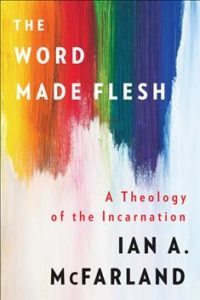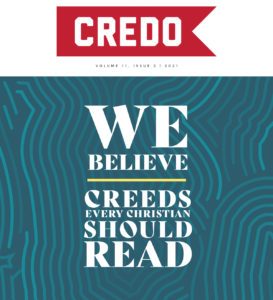Ian McFarland, the Robert W. Woodruff Professor of Theology at Candler School of Theology, argues in The Word Made Flesh (Westminster John Knox Press, 2019) that a “Chalcedonianism without reserve” provides “the most adequate account of Christian convictions regarding Jesus” (3). With the phrase “Chalcedonianism without reserve,” McFarland contends that Catholic, Orthodox, and Reformation theologies should not just share allegiance to the teachings codified in the Chalcedonian Definition. They should also embrace the full implications of those teachings, especially with respect to Jesus’ humanity. McFarland’s call to recover an expansive Chalcedonian Christology leads him to resource Chalcedon’s distinctions into modern theological debates. It also provides a foundation upon which McFarland offers constructive theological proposals, some generative and others problematic.
McFarland’s interest in Chalcedon originates from his belief that in modern theology, Jesus’ humanity receives inadequate and misguided doctrinal reflection. In McFarland’s estimate, theologians ostensibly committed to Chalcedon rarely present Jesus’ humanity as integral to his identity. Recent proposals that seek to redress this problem encounter their own issues. Kenotic Christologies and so-called Christologies from below emphasize the Word’s humanity but obscure his divinity.
As a remedy, McFarland draws upon the conceptual distinction between nature and hypostasis, a distinction that received maturation after 451 but that scholars rightly associate with the Chalcedonian tradition. In Chalcedonian Christology, the term nature denotes an entity’s constitutive attributes—in short, what the entity is. The term hypostasis refers, as Boethius defined it, to “an individual substance of a rational nature.” Hypostasis refers to who an entity is. In the incarnation, the hypostasis of the divine Son unites in his person two natures. There is one hypostasis—the Son—and two natures, God and human.
McFarland explicates two implications that emerge from this distinction between nature and hypostasis. The first is that “when we perceive Jesus of Nazareth, we perceive no one other than God the Son, the Second person of the Trinity” (8). This statement is true per the Chalcedonian tradition. In the person of Jesus, there is one acting subject, the hypostasis of the divine Son. McFarland secondly states that “when we perceive Jesus of Nazareth, we perceive nothing other than created substance, and thus nothing that is divine” (8). This statement expresses a desire to maintain the authenticity of Jesus’ humanity. Though the divine Son is the one acting subject in Jesus, the Son operates in this world as a human. The who of Jesus is the hypostasis of the divine Son; the what that humans perceive is Jesus’ human nature. The who of Jesus is the hypostasis of the divine Son; the what that humans perceive is Jesus’ human nature. Click To Tweet
McFarland’s attention to these two implications allows him to resource modern theology in several constructive ways. He addresses recent debates in Christology, concerns about theological method, and significant issues in soteriology.
Engaging recent debates in Christology, McFarland contends that his work engenders a consideration of Jesus’ humanity that avoids the difficulties associated with more modern proposals, such as kenoticism or so-called Christologies from below. His willingness to employ the Chalcedonian distinction between nature and hypostasis in conversation with these recent Christology discussions is helpful.
McFarland also demonstrates how a Chalcedonian-influenced account of Jesus’ human nature informs theological method. Such a Christology can preserve Christianity’s cataphatic and apophatic dimensions. Cataphatically, since the divine Son has taken on human flesh, we can arrive at some knowledge of God. God has come near to us. Nevertheless, in Jesus we do not perceive the divine nature per se. We perceive only the Son’s hypostasis as it operates in the human nature. This divine hiddenness preserves an important apophatic dimension; it upholds the “principle of the invisibility of the divine nature” and thus the need for humility when considering the divine (97).
Of all McFarland’s constructive proposals, the most interesting is his discussion soteriology. He presents the hypostatic union in such a way that “it bridges the divide between Creator and creature so as to draw creatures into God’s own eternal life” (9). With this language, McFarland refers to the doctrine of deification or theosis and contends that through grace, human beings and the broader creation can share in the divine life by participating in the divine energies. Here the central point of Jesus’ incarnation is not merely providing redemption from sin. It is the eventual bridging of the Creator-creature divide through creation’s glorification. This bridging does not negate the ontological distinction between creator and creature; rather, it allows the creature to share in the divine life through grace.
McFarland strongly emphasizes theosis—a trajectory that he shares with his former doctoral supervisor, Kathryn Tanner—and creatively employs the doctrine to develop his remarks about cataphatic and apophatic theology. Following a tradition set by such figures as Dionysius the Areopagite, he argues that Jesus’ humanity shares in the deification process. Through the deification of Jesus’ flesh, the divine nature’s invisible characteristics “become visible” to us (93). Jesus’ human nature can, in this way, disclose at least some knowledge of the divine. This disclosure engenders a cataphatic dimension to our theology, but its inherent limitations necessitate a continued reliance on an apophatic dimension as well.
McFarland’s proposals do benefit contemporary theology and merit careful attention, but some of his comments raise concerns, primarily because he can drive his conclusions too far. Two examples merit attention, one drawn from his singular focus on Jesus’ earthly life and the other from his portrayal of theosis. McFarland’s proposals do benefit contemporary theology and merit careful attention, but some of his comments raise concerns, primarily because he can drive his conclusions too far. Click To Tweet
McFarland focuses on the humanity of Christ—but only in the period between Jesus’ birth and death. He does not deny that Jesus’ resurrection, ascension, and second coming are objective realities. However, he interprets these events as not constituting additional sequences in Jesus’ life. These events receive a “demythologizing” so that they represent not the passing of a chronological sequence but merely the vindication that Jesus receives from his Father (180). McFarland likely has several Barthian concerns that lie behind this proposal. He has outlined his position in greater detail in his recent Candler Dean’s Lecture entitled “The Hope of Glory.”
His insistence that we consider only Jesus’ historical lifespan seems at odds with the New Testament. Paul commented that we know Christ no longer according to the flesh (2 Cor 5:16) and taught that the resurrected Christ serves as a template for our future resurrection bodies. Therefore, the ascension and the resurrection convey data about Jesus’s continuing personhood to which we must attend. The Christian tradition has made much of this data; Gregory of Nyssa’s Antirrheticus adversus Apolinarium serves as but one notable example.
Concerning theosis, while McFarland’s interest in the doctrine is welcome, he unnecessarily employs the concept to attack certain atonement theologies. He argues that his portrayal of Christ as one who bridges the creature-creature divide “has nothing to do with a need for propitiation, as though the divine honor or wrath or even justice requires some sort of compensatory payment” (218-219). Indeed, McFarland claims that theologies that emphasize honor, wrath, and justice insufficiently conceive of Jesus. He alleges that they exclusively focus on the reason for Jesus’ death without adequately considering the fullness of Jesus’ life.
Theosis is a Christian understanding of salvation that many contemporary Protestants are rightly starting to recover; however, accepting the doctrine does not necessarily entail a rejection of such concepts as divine honor or divine wrath. McFarland here seems to rely on stereotypes of satisfaction-oriented understandings of the atonement.
McFarland’s Word Made Flesh merits commendation for its erudite nature, breadth, and creativity. The work confirms that he serves as one of the most skilled theologians operating today. Many of McFarland’s creative proposals will rightly receive attention in future Christology discussions. Readers should simply be careful with his more problematic suggestions.


